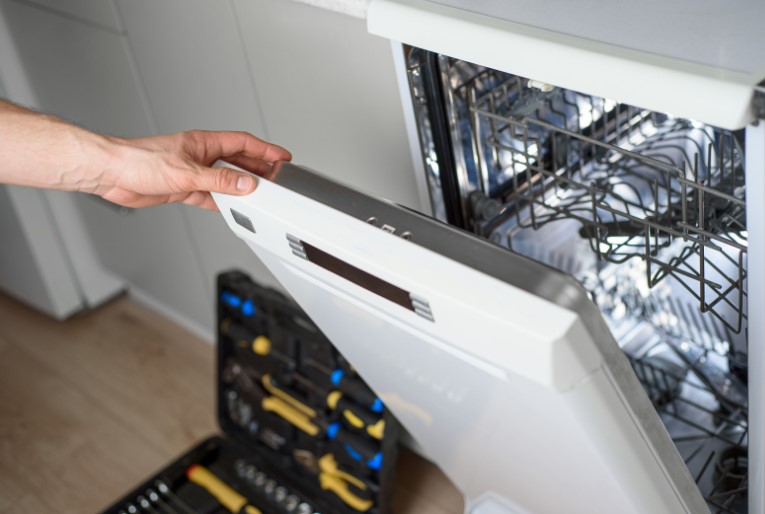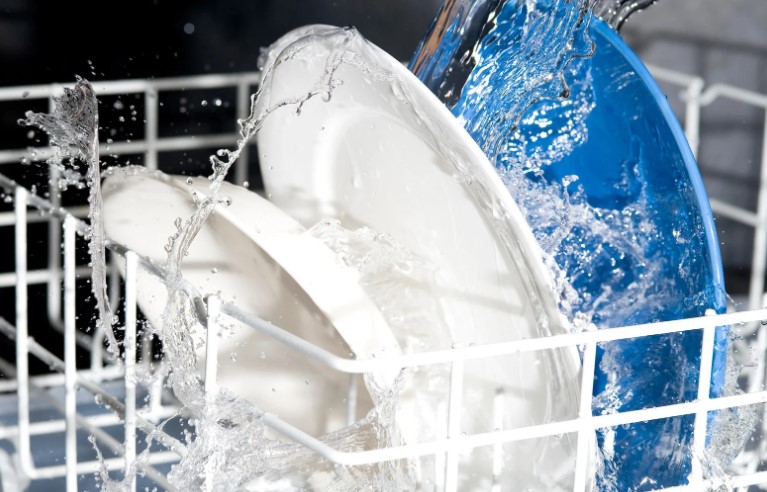Having standing water in your dishwasher can be frustrating and inconvenient. Not only does it leave your dishes dirty, but it can also signal a more significant issue within the appliance. In this guide, I’ll walk you through the steps on how to unclog a dishwasher with standing water and get it back to working order.
What Causes Standing Water in a Dishwasher?
Before diving into the solution, it’s essential to understand what might be causing the problem. Several factors can lead to standing water in your dishwasher, including:
Blocked Dishwasher Filter
The dishwasher filter plays a vital role in filtering food particles and debris. If the filter becomes clogged, it can prevent water from draining properly, leading to standing water at the bottom of your dishwasher.
Clogged Drain Hose
Another common cause is a clogged drain hose. The connection between the dishwasher and the sink drain is by the drain hose. Meanwhile, food particles, grease, or even small objects can lead to blockage in the hose, preventing water from draining.
Drain Pump Issues
The drain pump has the responsibility to push the water out of the dishwasher. If the pump is faulty or blocked, it may not function correctly, causing water to remain in the dishwasher.
Garbage Disposal Connection
If your dishwasher is connected to a garbage disposal, then a blockage in the disposal can also cause water to back up into the dishwasher. Ensuring the garbage disposal is clear is an essential part of troubleshooting this issue.
How to Identify a Clogged Dishwasher?
Knowing how to identify a clog is the first step toward fixing the problem. Here are some signs that your dishwasher isn’t draining properly:
Signs Your Dishwasher Isn’t Draining Properly
- Water collecting at the base of the dishwasher after a cycle.
- Unusual sounds during the drain cycle, such as gurgling or humming.
- Dirty water backflow, where dirty water re-enters the dishwasher after draining.
How to Check the Dishwasher Filter
The dishwasher filter is a common culprit when it comes to drainage issues. Follow this to check and clean it:
- Remove the bottom rack to access the filter.
- Locate the filter—typically found at the bottom center of the dishwasher.
- Twist and remove the filter following the manufacturer’s instructions.
- Inspect the filter for any debris or food particles that might be blocking it.
Cleaning the Filter
Once removed, clean the filter under running water. Use a soft brush material to remove any stubborn particles. Make sure the filter is thoroughly clean before reinserting it into the dishwasher.
Inspecting the Drain Hose
It’s time to inspect the drain hose, once the filter is clean. Here’s how you can do it:
- Turn off the power to the dishwasher to ensure safety.
- Locate the drain hose—it’s usually connected to the sink drain or garbage disposal.
- Disconnect the hose carefully, ensuring you have a towel or bucket handy to catch any water.
- Check for blockages by running water through the hose or using a long flexible brush.
Disconnecting the Hose Safely
When disconnecting the hose, ensure you follow the manufacturer’s guidelines to avoid damaging the hose or any other components.
Step-by-Step Guide to Unclogging a Dishwasher with Standing Water
Now that you’ve identified the possible cause, let’s move on to the steps to unclog your dishwasher.
Step 1: Turn Off the Power
Safety first! Before you begin any work, turn off the power to the dishwasher. It is the foremost thing to be done by unplugging or switching off the circuit breaker.
Step 2: Remove Standing Water
Next, you’ll need to clear up the standing water from the dishwasher. You can do this using a cup or a bowl to scoop out the water, followed by a towel or cloth to soak up any remaining moisture. A wet/dry vacuum can also be handy for this task.
Step 3: Clean the Dishwasher Filter
As mentioned earlier, cleaning the filter is crucial. If you haven’t done this yet, now is the time to remove and clean it thoroughly.
Step 4: Check the Drain Hose
Revisit the drain hose and ensure it’s free from blockages. This step is essential to ensure water can flow out of the dishwasher properly.
Step 5: Inspect the Drain Pump
If the filter and hose are clear, the drain pump could be the problem. You’ll need to access the drain pump, which might involve removing the dishwasher’s bottom panel. Inspect the pump for debris or obstructions and clean it if needed.
Step 6: Run a Test Cycle
Once everything is cleaned and reassembled, run a short dishwasher cycle to see if the water drains correctly. If the dishwasher drains as it should, congratulations—you’ve successfully unclogged it!
Preventing Future Clogs in Your Dishwasher
To avoid dealing with standing water again, regular maintenance is key. Following are a few tips to run your dishwasher smoothly:
Regular Maintenance Tips
- Clean the filter at least once a month.
- Run a cleaning cycle with vinegar or a commercial dishwasher cleaner to remove grease and grime.
- Inspect the drain hose periodically to ensure it’s clear.
Proper Use of Dishwasher
- Try to remove the unwanted food particles which are large in size from dishes before loading them into the dishwasher.
- Avoid placing items that can cause clogs, such as toothpicks or large food chunks, into the dishwasher.
When to Call a Professional?
While many clogs can be fixed with DIY methods, there are times when you might need professional help.
Persistent Problems
If you’ve followed all the steps and the dishwasher still isn’t draining, it might be time to call a professional. Persistent issues could indicate a more serious problem with the dishwasher’s internal components.
Complex Repairs
Some repairs, such as replacing a faulty drain pump, may require specialized tools & expertise. In such cases, it’s best to leave it to a qualified technician.
Conclusion
Unclogging a dishwasher with standing water might seem daunting, but by following these stepson how to unclog a dishwasher with standing water, you can often resolve the issue yourself. Regular maintenance and proper use of your dishwasher can help prevent future clogs and keep your appliance running efficiently.





0 Comments